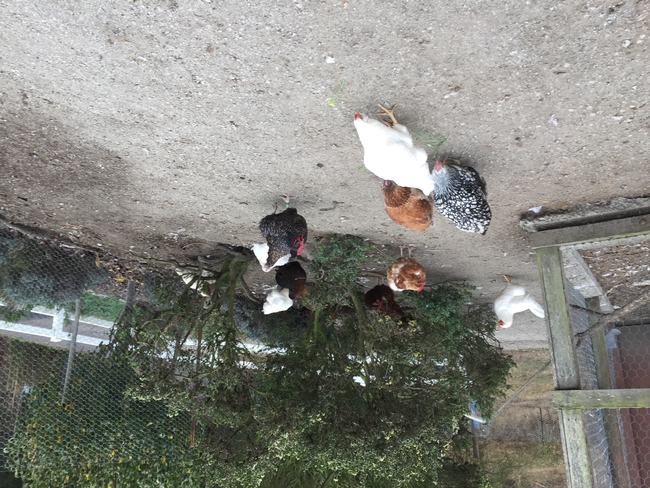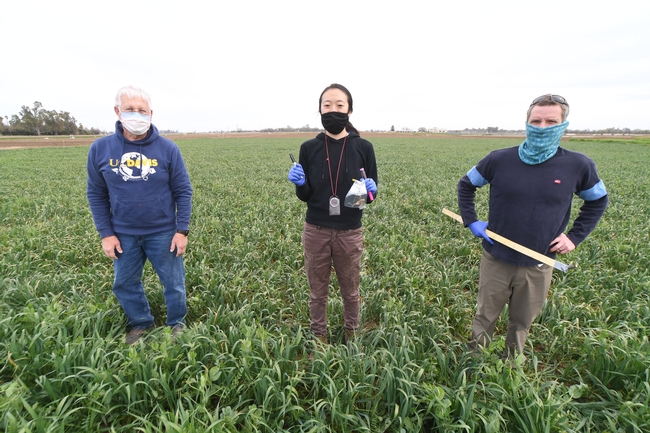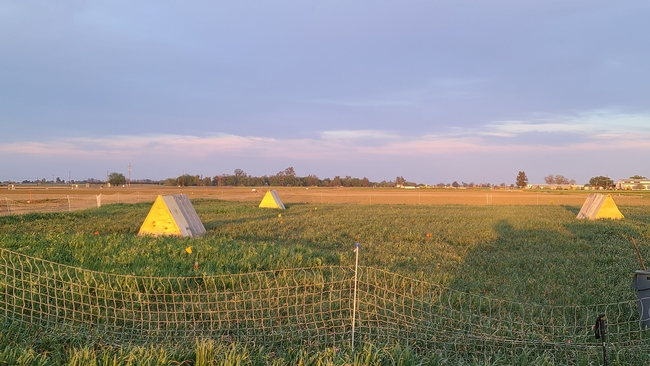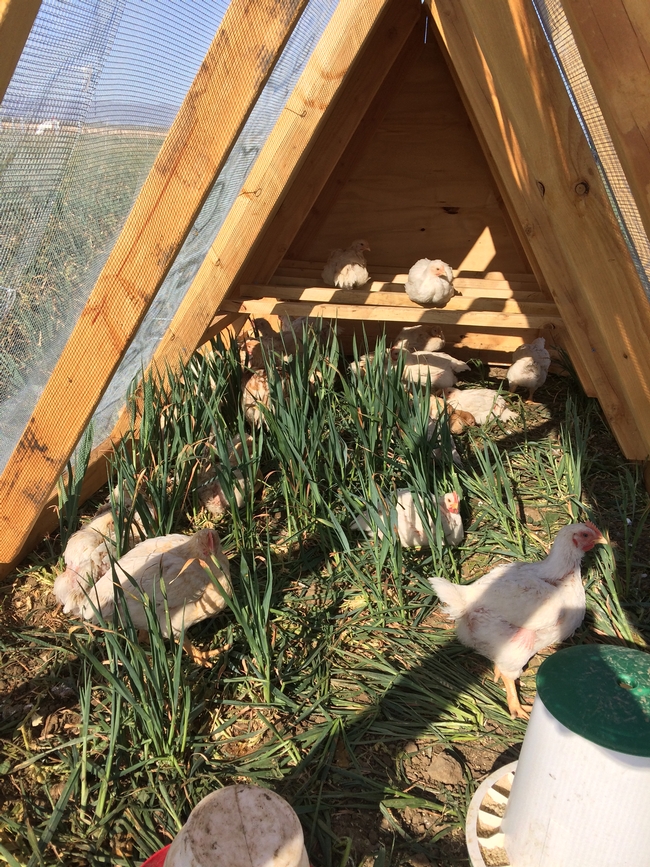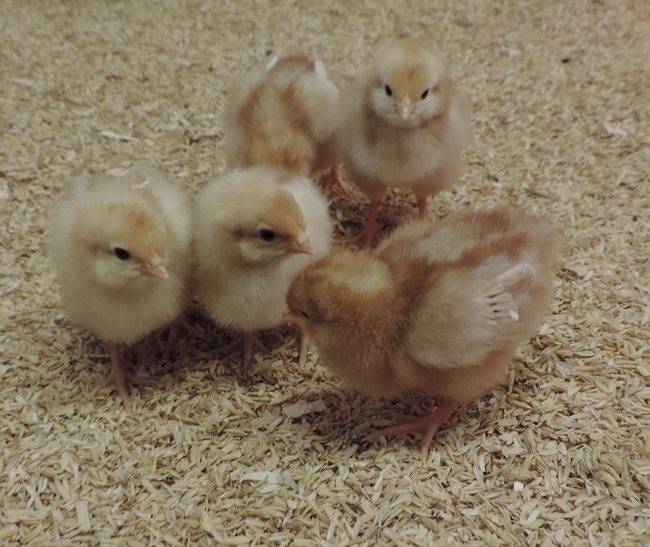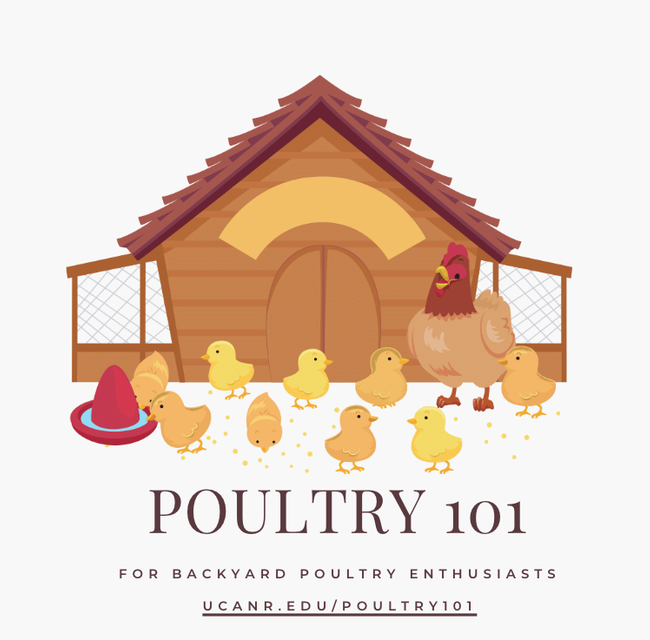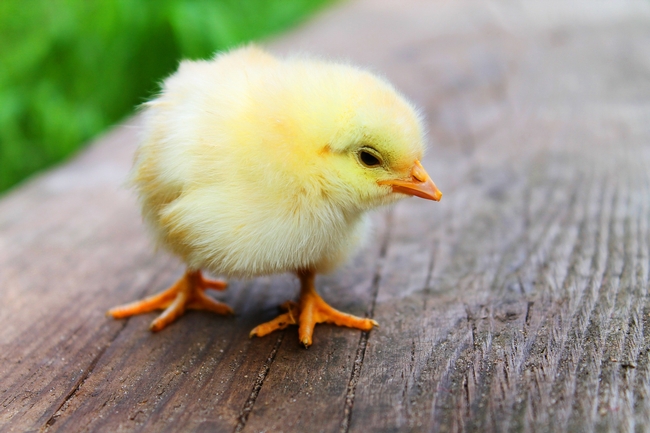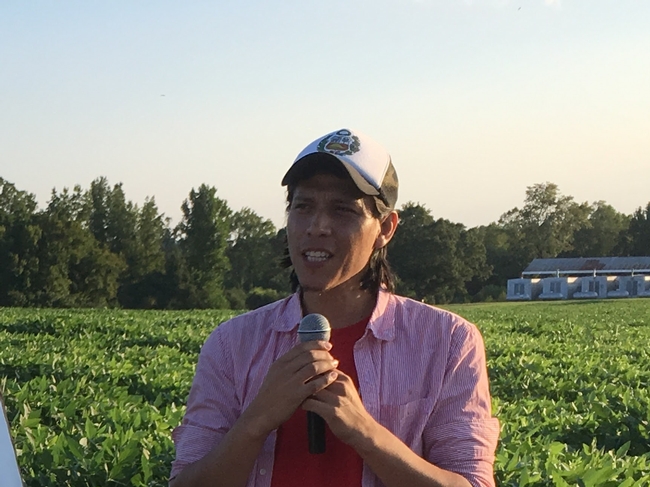Posts Tagged: Maurice Pitesky
Poultry owners urged to protect birds from avian influenza virus
A strain of highly pathogenic avian influenza is currently infecting and killing wild birds and domestic birds in at least 29 states across the United States.
A UC Agriculture and Natural Resources poultry expert urges commercial and backyard chicken owners to take precautions.
“When it comes to protecting your flock, there is no treatment for HPAI so the best thing you can do is focus on biosecurity,” said Maurice Pitesky, UC Cooperative Extension poultry specialist in the School of Veterinary Medicine at UC Davis.
“In order to protect our commercial and backyard chickens, it is essential for all of us who own poultry to do our part,” he said.
The current avian influenza outbreak is already considered the worst bird flu outbreak since the 2015 HPAI outbreak when nearly 50 million poultry were euthanized or died.
The HPAI virus is being spread by migrating birds and California is part of the Pacific migratory flyway.
“Waterfowl migrate thousands of miles between wintering and breeding locations and have long been known to be the natural reservoirs for avian influenza viruses, which are associated with high mortality in poultry,” Pitesky explained. “Many of these migrating ducks, geese and swans winter in the relatively warmer climate of California's Central Valley among other locations where they can find appropriate habitat.”
Pitesky recommends preventing chickens and other poultry from exposure to waterfowl and other potential wild bird carriers.
“At the most generic level, that means making sure your birds are separated from any wildlife,” he said. “Whether you have a million-bird farm or just a few backyard chickens, the message is the same: maintain the best biosecurity you can, which includes fencing and make sure you reduce reasons for waterfowl to come near your birds such as spilled feed and ponding of water.
“Our previous research has shown that waterfowl are attracted to both natural and human-made wetlands and lagoons. So, if you live near one of these types of habitats, your biosecurity efforts are even more important.”
The HPAI virus does not currently affect humans. Pitesky said it is important to recognize that avian influenza viruses, like all viruses, can mutate or recombine to form new versions of virus that may affect humans.
For more information on biosecurity and where HPAI has been identified in the U.S., please visit the UC Cooperative Extension poultry website at https://ucanr.edu/sites/poultry/Resources_335/HPAI.
Poultry owners who have questions may reach Pitesky at mepitesky@ucdavis.edu.
Scientists to see whether chickens boost soil health, increase profits on organic vegetable farms
Historically, chickens were not a rare sight on farms, where they contributed to soil fertility as they freely pecked and scratched around vegetable gardens and crop land. Now, UC Cooperative Extension specialists have launched a research project to quantify the potential for chickens to be part of safe and sustainable commercial organic vegetable production.
“It's not a new idea. A lot of farmers are trying this kind of thing,” said UC Davis International Agriculture and Development graduate student Faye Duan, the project coordinator. “But there is currently little scientific information for using chickens on a bigger scale, especially in terms of food safety concerns.”
The California trial is part of a national effort to diversify organic vegetable farms with chickens. Last year, the USDA-funded study was launched by Iowa State University horticulture professor Ajay Nair. The project also includes UC Cooperative Extension specialists Maurice Pitesky and Jeff Mitchell, based at UC Davis, and University of Kentucky entomology professor David Gonthier.
In the trials, chickens are introduced as part of a rotation that includes cover crops and a variety of vegetable crops. In California, chickens were placed on research plots in April following a winter cover crop of vetch, peas, fava beans and oat grass.
“We don't let the chickens run around the field,” Duan said. “We keep them inside of chicken tractors to protect them from predators.”
Twenty-nine birds live in each 50-square-foot tractor, essentially a floorless chicken coop on wheels. The tractors, built by UC Davis students Mallory Phillips and Trevor Krivens, are wood frames covered with mesh and plywood. Each day, the tractors are moved to a different part of the plot, where the birds can graze on cover crop residue and deposit manure. Adjusting to the daily move took time, Duan said.
“The first day, the chickens were confused. We had to go slowly. It's a learning process for the chickens and us,” she said. “But now, the chickens are excited to move to a new spot where they have fresh food to graze on.”
After 24 days on pasture, the chickens will be removed, and become part of the project's meat study.
“We have broiler chickens that are raised for meat,” Duan said. “Some people believe chickens that graze and eat grass taste better and are more nutritious. It will be part of the study to look at the chicken's meat quality.”
Once the chickens have done their part on the research plots, vegetables are planted amid the leftover cover crop residue and chicken manure. This summer, the experiment in California will grow processing tomatoes. Subsequently, melons, eggplant, spinach and broccoli will be part of the vegetable rotation in California or the other states involved in the project. Other replications of the trial will have the chickens immediately follow the vegetable harvest so they can graze on the crop leftovers before the cover crop is planted. Comparing the soil health, fertilizer needs, chicken quality and other factors will help the scientists optimize the rotation.
“Vegetable yield will be an important indicator of success,” Duan said.
Soil samples will be tested to determine the presence or absence of Salmonella bacteria after the chickens have been removed, said Pitesky, a poultry specialist and a project lead. Salmonella is a bacterium that can be part of poultry's microbiome. If the bacteria contaminates human food, it can cause illness.
“Since Salmonella lives in the chicken gastrointestinal system, when it gets into the soil, it will eventually be out-competed by bacteria more adapted to soil than the gut of a chicken,” Pitesky said. “There are many different types of Salmonella, and only a select few found in birds are the ones that are harmful to humans. Nevertheless, it is very important to test and use various practices to mitigate the presence of Salmonella on land that will be used for crop production following poultry.”
Early results of soil tests in Iowa and Kentucky detected Salmonella in the soil where chickens grazed, however, the bacteria disappeared very quickly.
Poultry 101 guides new parents of chicks
As Californians began sheltering in place at home, they started growing their own food. In addition to gardening, people have begun adopting chickens for fresh eggs. For people who have little to no experience raising poultry, University of California Cooperative Extension has care and feeding tips to keep the birds healthy.
UCCE dairy advisor Randi Black and Karen Giovannini, UCCE agriculture ombudsman for Sonoma County, collaborated with UCCE poultry specialist Maurice Pitesky in the School of Veterinary Medicine to create Poultry 101. Their tips for new poultry owners are free at http://ucanr.edu/poultry101.
“Raising chicks and hens can be incredibly rewarding, particularly with delicious farm fresh eggs made right in your backyard,” said Black, who is also proud backyard poultry parent. “However, like other animals, they take a lot of care and management to ensure they stay healthy and productive. With new poultry parents on the rise, providing informative and accessible resources is critical to keeping our backyard flocks thriving.”
The guide covers the needs of chickens over their lifespan, from the time they hatch through retirement.
For warmth, baby chicks huddle under their mother hen. Without a hen, new owners must provide the appropriate ambient temperature based on the age of the chick. Poultry 101's “Chick temperature chart” recommends temperatures for chicks from hatch to 6 weeks old.
At around 18 weeks of age, one can eggs-pect pullets to lay their first egg.
"Backyard poultry can be educational and fun. Using UCCE tools like 'Poultry 101' are meant to provide science-based practical resources to raise healthy poultry,” Pitesky said.
Chickens join the list of 'shelter-in-place' must-haves
Like flour, yeast, toilet paper and hand sanitizer, all over the country there's been a run on chicks, wrote Diana Williams in a article published by the Sacramento Bee. The author and her family adopted four chicks, and as they grew, so did her thirst for information on raising chickens at home.
"Imagine my delight in stumbling across a backyard chicken census online," Williams wrote.
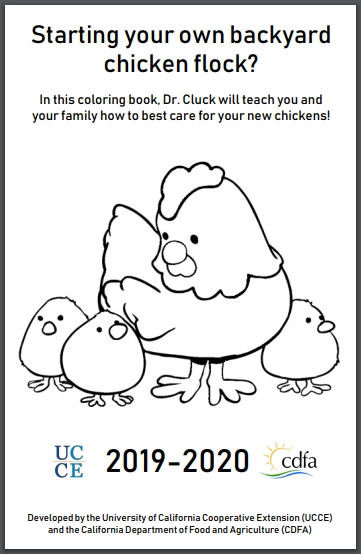
Pitesky said there are about 100,000 backyard flocks in California. Sacramento probably has about 11 percent of them, making it the third-highest backyard chicken region in the state, behind Los Angeles and San Francisco.
Raising backyard chickens seems to be another somewhat senseless hoarding practice taking place during the COVID-19 crisis. Williams admitted that, "this isn't exactly logical if you consider it's about half a year until chicks lay eggs." She speculated that a search for meaning, purpose and connectedness during COVID-19 uncertainty is another driver of chicken adoption, along with suddenly having more time at home.
"So the prospect of being able to have new life inside our house – life that's warm, fuzzy and unfolding in a new way every day – that seemed more than inviting. It felt essential," Williams wrote.
Industry producers are concerned about the trend.
“We don't like all these people getting into backyard birds,” said Bill Mattos, president of the California Poultry Federation. “People start out trying to grow their own eggs and find out it's not so much fun. Instead of trying to get rid of them properly, people turn them loose and they develop a disease. That's what scares the commercial industry.”
ANR in the news April 1-18
How One Entomologist Found His Calling as an IPM Facilitator
(Entomology Today) Lina Bernaola, April 18
Alejandro Del Pozo-Valdivia, Ph.D., is currently an IPM entomology advisor at the University of California Cooperative Extension. He serves the vegetable industry in the Central Coast region of California by conducting applied research on pest management and implementing an extension program for stakeholders.
Alejandro was born and raised in Lima, Peru, where he earned his bachelor's degree in agronomy from La Molina National Agrarian University. Then, he went to Washington State University, where he obtained his master's degree in entomology working on integrated pest management (IPM) in irrigated hybrid poplars. In 2016, he obtained his Ph.D. in entomology at North Carolina State University (NCSU). During his doctoral studies, he worked on proposing management practices for the kudzu bug, an invasive pest of soybeans.
America's leading animal geneticist wants to talk to you about GMOs
(Pacific Standard) Emily Moon, April 18
At 11 a.m. on a Thursday morning, Alison Van Eenennaam is sitting in a harshly lit lab room, surrounded by her graduate students, talking about cattle sex—sex that, unfortunately, has not gotten anything pregnant. With the gene-editing techniques she's using, there could be many factors to blame: the location in the DNA strand of the edit, the biopsy performed to check the results of the edit, the freezing and the thawing of the embryo, the embryo's journey from lab to farm in a thermos. Now, Van Eenennaam floats another idea. "No foreplay, the poor guy," she says, a cheeky grin on her face. "The candle and the lighting wasn't right."
https://psmag.com/environment/americas-leading-animal-geneticist-wants-to-talk-to-you-about-gmos
UCCE Marin Creates Online 'Story Map' Annual Report
(Patch) Susan C. Schena, April 16
The University of California Cooperative Extension team in Novato has created an online "story map" that capsulizes in an interactive way its ongoing programs and key 2018 accomplishments, instead of a written annual report.
https://patch.com/california/novato/ucce-marin-creates-online-story-map-annual-report
An Inviting Summary of UCCE Marin's Exploits
https://postnewsgroup.com/2019/04/18/an-inviting-summary-of-ucce-marins-exploits/
Why bees swarm and what you should – or shouldn't – do about them
(San Jose Mercury News) Rebecca Jepsen, April 16
…Last year was a particularly bad year for honey bees. Some bee keepers reported up to a 90 percent loss in their hives in 2018. Causes for this include varroa mite infestations, increased pathogens due to the warm weather, increased use of pesticides and a decrease in diversity of food sources.
So, what can we do about a swarm? “If you leave the bees alone, they will leave you alone.,” said Dr. Elina L. Niño, honey bee expert at UC Davis. “It only takes a few hours or at most a day or two for them to find and settle into their new home.”
https://www.mercurynews.com/2019/04/16/why-bees-swarm-and-what-you-should-or-shouldnt-do-about-them/
Santa Maria expects big strawberry crop
(The Packer) Carol Lawrence, April 16
…Two of the three top-yielding varieties in production yield studies conducted in Watsonville by the University of California, Davis, include the monterey variety, producing 10,554 cartons per acre, and the san andreas variety, which yielded 10,414 cartons per acre. O'Donnell said the commission has noticed those varieties as well as some proprietary ones from growers.
“We're seeing more fruit per acre from when these fruits are planted,” she said.
A newer variety, the cabrillo, was reported as producing 11,605 cartons per acre in recent tests.
https://www.thepacker.com/article/santa-maria-expects-big-strawberry-crop
These California communities could be the next Paradise. Is yours one of them?
(Sacramento Bee) Ryan Sabalow, Phillip Reese and Dale Kasler, April 11
…“There's a lot of Paradises out there,” said Max Moritz, a fire specialist at UC Santa Barbara.
California's state-of-the-art building codes help protect homes from wildfire in the most vulnerable areas, experts say. But the codes only apply to new construction. A bill introduced by Assemblyman Jim Wood would provide cash to help Californians retrofit older homes.
“This will go a long way toward these different municipalities (in showing) that they deserve funding,” Moritz said.
https://www.sacbee.com/news/state/california/fires/article227589484.html
U.C. Davis Animal Science Professor Discusses Agriculture's Contribution to Climate Change
(Cornell Sun) Stacey Blansky, April 11
On Monday afternoon, Prof. Frank Mitloehner, animal science and Air Quality Extension Specialist at the University of California, Davis, discussed the latest research surrounding animal agriculture and its “surprisingly modest” contribution to global greenhouse emissions. Mitloehner pointed at food waste as the largest contributor to environmental damage.
Scientists studying smoke taint as next fire season approaches
(Farm Press) Lee Allen, April 10
…A Los Angeles Times report on the subject put it this way - “Smoke taint rears its head when grapes, kissed by environmental smoke as they're growing, eventually yield a wine with unexpected smoldering flavors…, ‘like drinking from a well-used ashtray,'” using the words of University of California-Davis enology specialist Anita Oberholster. The story noted: “It's a vintner's worst horror movie nightmare - the smoke is coming from inside the grapes.”
Says Oberholster: “Compounds that are responsible for smoke taint are naturally present in grapes at low levels, they add complexity to the wine. Research into the subject is a slow process and to date, I can say there is very little you can do to prevent extracting smoke taint compound from grapes. We are currently in the process of evaluating different amelioration techniques from finished wines and there is some promise there, but research is still on-going, and I have no data yet.”
https://www.farmprogress.com/grapes/scientists-studying-smoke-taint-next-fire-season-approaches
The farmer that saw his budding California tea farm go up in smoke
(San Francisco Chronicle) Jonathan Kauffman, April 8
…What Mike Fritts didn't know in 2010 — what almost everyone had forgotten, in fact — was that the UC Extension Service planted California's first modern test plot of Camellia sinensis in Fresno in the 1960s, when it partnered with Lipton.
Jacquelyn Gervay Hague, a chemist at UC Davis who conducts studies of tea-growing in Taiwan and is active in the university's Global Tea Initiative, said she learned about the plots just a few years ago when the director of UC Extension's Fresno office gave her a call.
“It blew my mind,” Hague says. She pored over the records, which covered 1963 to the early 1980s, when Lipton pulled out of the study. “It was concluded that we could grow tea very well,” she said.
https://www.sfchronicle.com/food/article/The-farmer-that-saw-his-budding-California-tea-13745160.php
Goats are the latest weapons in the war against wildfire
(CNN) Sarah Lazarus, April 8
… Lynn Huntsinger, professor of range ecology and management at the University of California, Berkeley, says that California has seen an increase in "fuel" -- the term fire experts use to describe "dead plants."
Huntsinger, who used to keep goats in the backyard of her Bay Area home, says the fire problem has its roots in history.
In the past, Native Americans lit fires to control the vegetation, she says. These deliberate burns created a landscape of open grasslands, so wildfires were smaller and less frequent.
That changed with the arrival of colonial settlers. They did not understand how "using fire prevented fire," and banned deliberate burns from around the turn of the 20th century, says Huntsinger.
https://www.cnn.com/2019/04/08/americas/goats-and-wildfires-intl/index.html
The Age of Robot Farmers
(The New Yorker) John Seabrook, April 8
…To get an idea of what might be possible, I arranged to visit Professor David Slaughter in his office at the University of California at Davis. Slaughter leads the university's Smart Farm Initiative, which explores how future farmers might employ emerging technologies. Drones, for example, can automate the inspection of fields for pest or weed outbreaks, and can use high-resolution cameras and algorithmic processing of the images to pick up incipient problems before a farmer or a hired hand might spot them. Another possible application is plant breeding. Breeders currently rely on humans to evaluate seedlings produced by new combinations of already existing varieties.
…If the future of fruit-and-vegetable farming is automation, farmers will not only need the machines, and the funds to afford them, they will also require a new class of skilled farm workers who can debug the harvesters when something goes wrong. Mary Lou de Leon Siantz, a colleague of David Slaughter's at the University of California at Davis, is trying to ensure that domestic farmworkers' children have the STEM skills to compete for those jobs. De Leon Siantz is the daughter of Mexican immigrants; she has a Ph.D. in human development and focusses on migrant health in her research. She hopes to use existing Head Start and 4-H programs to teach math and engineering.
https://www.newyorker.com/magazine/2019/04/15/the-age-of-robot-farmers
Regional sustainable groundwater management forum hosted in Corning
(Red Bluff Daily News) Julie Zeeb, April 5
Tehama and Butte counties teamed up Friday to host a Northern Sacramento Valley forum on sustainable groundwater held at Rolling Hills Casino.
The event was a collaboration between the Tehama County UC Cooperative Extension and Butte County Department of Water and Resource Conservation.
Allan Fulton, a Tehama County farm advisor, served as moderator.
“We're four years into Sustainable Groundwater Management Act that went into affect Jan. 1, 2015,” Fulton said. “There's been a lot of organizing (of groundwater management agencies). Now the governance structure and planning is underway. This venue is perfect for people to learn about the act and what is going on locally. It's a chance to see, as landowners and water operators, how to engage in the process and give feedback on what they think about it.”
The worst fire in California history illuminates fire preparation needs
(Yuba Net) April 5, 2019
Four months have passed since the Camp Fire, the worst wildfire in California history, ravaged bucolic communities in the Butte County foothills, including Paradise, Concow, Butte Creek Canyon, Cherokee, Yankee Hill and Magalia. Eighty-five people died, many of them elderly and unable to safely evacuate from an area where a wind-driven fire raced from home to home.
The unspeakable loss of human life and the serious challenges being faced by survivors has dominated the Camp Fire conversation. Now, UC Cooperative Extension is beginning a dialog with many agencies involved to understand how such tragedies can be prevented in the future.
https://yubanet.com/regional/the-worst-fire-in-california-history-illuminates-fire-preparation-needs
UC course helps landowners track water use
(Farm Press) Tim Hearden, April 5
On a recent morning, Jim Edwards and about 70 of his fellow farmers and ranchers from Northern California went back to school. Each was handed a binder full of worksheets as they embarked on a three-hour course to learn how to measure and report their own water diversions – a state requirement now for landowners with rights to draw water from a river or stream.
There were lectures by University of California Cooperative Extension advisors and were even quizzes at the end of each unit so the landowners could demonstrate what they'd learned about open-ditch flow readings, measuring weirs, in-pipe flow meters, the calibration and accuracy of measuring devices, and measuring reservoir diversion quantities.
“I think it's great,” said Edwards, who takes water from Antelope Creek near Red Bluff to raise cattle, orchards and hay.
… “I think this is a good crash course to get people to understand flow measurements and what is required of them to report,” says Khaled Bali, a UCCE irrigation specialist who helps lead a course unit on device accuracy.
https://www.farmprogress.com/extension/uc-course-helps-landowners-track-water-use
DIY with classes at the UC Cooperative Extension in gardening and food preservation
(New Times SLO) Camillia Lanham, April 4
A soft-hued planter full of pale gray-greens and purple flowers waits just through the gate of the Garden of the Seven Sisters off Sierra Way. Those winter colors will soon be replaced by flora made just for spring. This "curbside garden" is the first of 15 demonstration plots manned by Master Gardener Program volunteers at the UC Cooperative Extension in San Luis Obispo.
If you're a newbie like I am—or an oldie looking for some new tricks—the UC Cooperative Extension in San Luis Obispo County has got something just for you. Whether you're trying to figure out what to do with all of that extra produce on your kitchen counter or trying to decide exactly what to plant and when, there's probably a class for that either through the extension's Master Gardener Program or Master Food Preserver Program. You can become certified as a master and volunteer for either program or both programs, or you can dabble with a class here or there.
Backyard chickens hit hard by a long-gone, extremely contagious disease
(New Food Economy) Tove Danovich, April 4
In California, backyard birds are in lockdown. County fairs are canceling their poultry shows. Veterinary hospitals aren't accepting chicken appointments. Local 4-H leaders are telling chicken owners to keep their birds sequestered. Some poultry breeders are even worried their birds will need to be euthanized.
… There are approximately 100,000 backyard flocks in California according to Maurice Pitesky, Cooperative Extension poultry specialist with the University of California, Davis, School of Veterinary Medicine. “They don't focus so much on biosecurity, which is just a fancy word for disease prevention,” he says. Backyard poultry owners regularly mock the CDC's advice to avoid snuggling or kissing their chickens, but that's not the worst of it: 25 percent of urban poultry owners reported not even washing hands after handling their birds.
https://newfoodeconomy.org/virulent-newcastle-disease-poultry-backyard-chicken-coops
Dr. Monica Cooper to be honored at ASEV in Napa June 19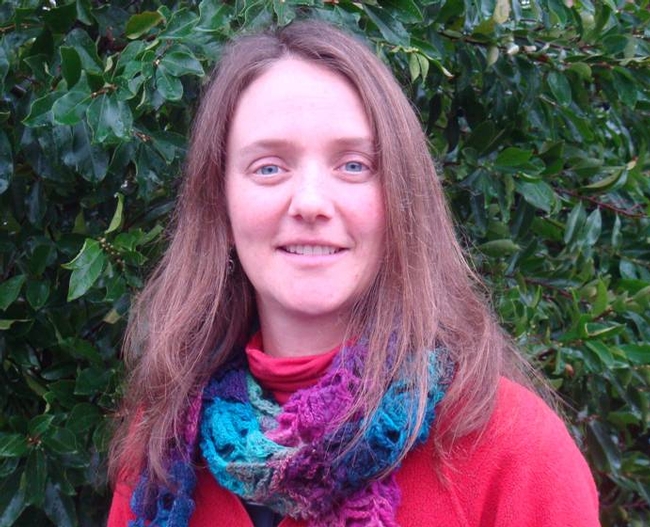
(Napa Valley Register) April 4
Dr. Monica Cooper, farm adviser of UC Cooperative Extension, Napa Valley, is the recipient of the American Society for Enology and Viticulture's (ASEV) Extension Distinction Award for 2019.
Cooper will receive the award at the 70th ASEV National Conference on June 19 in Napa, where she will be presenting, “Building Effective Extension Networks to Support Data-Driven Decision Making.”
It Wasn't Just the Soda Tax That Dropped Berkeley Soda Sales by 52 Percent
(The Inverse) Emma Betuel, April 3
University of California, Berkeley professor Sofia Villas-Boas, Ph.D., and Ph.D. candidate Scott Kaplan show in the new paper that soda purchases fell between 10 and 20 percent on Berkeley's campus directly after the soda tax was passed but before the prices officially increased in 2015. They also used Nielsen data to show a similar pattern: soda purchases at local stores decreased by 10.8 percent even before the higher prices went into effect.
“The election outcome caused a 10-20% reduction in sales of regular soda beverages before consumers faced higher prices anywhere, on campus or in stores off-campus,” Kaplan tells Inverse, “This suggests that you might not witness these types of effects if a sugar-sweetened beverage (or soda) tax was implemented without a preceding campaign and public vote.”
https://www.inverse.com/article/54577-soda-taxes-and-changing-social-norms
UC IGIS to host DroneCamp 2019 in Monterey
(Santa Cruz Tech Beat) Sara Isenberg, April 2
The Informatics and GIS Program (IGIS) of University of California's Division of Agriculture and Natural Resources is pleased to host the second offering of DroneCamp. This three-day intensive workshop covers everything you need to know to use drones for mapping, research, and land management, including…
Tiny whiteflies seem to be bugging people across the Central Coast, but why are there so many this year?
(KSBY) Megan Healy, April 1
A master gardener from the SLO University of California Cooperative Extension says dozens of people from south SLO County called asking why there are so many.
“It's probably a reflection of the increasing temperatures coming on top of all that nice water we have had, so we have had a flush of vegetation and the flies that came from eggs originally have just all hopped out,” said Cathryn Howarth, a master gardener a the SLO County UC Cooperative Extension.
According to the UC Agricultural and Natural Resources Statewide Integrated Pest Management Program, signs of whitefly manifestation include…
Inside the race to build the burger of the future
(Politico) Michael Grunwald, April 1
…Conglomerates like Walmart, McDonald's and General Mills have been setting emissions reduction targets for their suppliers, which will ratchet up pressure on farmers and ranchers to green their operations. But at a time when they're already getting squeezed by a handful of giant agribusinesses that process their animals, as well as the economic fallout from President Donald Trump's trade wars, they're hoping for government incentives to reduce their emissions. Frank Mitloehner, a professor of animal agriculture at the University of California-Davis, believes farmers and ranchers deserve to be paid for their ecological services—and recently said so to an Ocasio-Cortez staffer. For example, California is spending hundreds of millions of dollars to help them manage their manure in cleaner ways, which makes more sense to Mitloehner than demonizing them for the messes they make while putting food on people's tables. Many of them are conservative Republicans who deny climate science, but they're also pragmatic businesspeople—Mitloehner says they could store tremendous amounts of carbon on their lands if the price and the politics were right.
“Politically, farmers tend toward the Trump camp, and when they hear all this finger-pointing about farting cows, they just shut down,” Mitloehner says. “It troubles me, because I know how urgent this climate discussion is.”
… “There's such an enormous opportunity to reduce emissions in meat production, if you didn't hear all this counterproductive talk about how everything about it is terrible,” says Mitloehner, the Cal-Davis agricultural scientist. “Let's not alienate the people we need the most on our quest for a climate solution.”
https://www.politico.com/magazine/story/2019/04/01/meat-politics-226342
